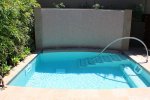First -
All thinsets and grouts can contribute to efflorescence, since they all contain lime (calcium). In the presence of air and water, the lime is activated and begins to crystalize. This is why it primarily only occurs above water. Constant wetting and drying of a wet wall fountain, vanishing edge wall or water weeping through the shotcrete (gunite) can also activate the lime.
Secondly -
Materials expand and contact in the presence of heat and cold. Glass tiles on a vanishing edge or wet wall will expand in the sun, until they are doused with cool water when the pump activates. Suddenly the glass contracts. Thermal expansion cracking, is what led to the development of the ANSI 137.2 Thermal Shock standard and classifications. Glass is rather brittle and does not handle thermal shock well. This is why glass tiles works well as a kitchen back splash and poorly in a shower or steam bath.
Thirdly -
On a round spa, as the glass tiles expand the circumference of the circle enlarges. The spa structure will not expand at the same rate and the tiles will come loose (routine expansion joints will help). In an effort to relieve this stress, cracks may form randomly. On a spill over or vanishing edge spa, the water will now have easy access to the thinset, mortar bed or shotcrete (if the installer did not utilize a waterproof membrane). This only encourages more efflorescence. Many people incorrectly interpret these cracks as structural cracks. If they do not line up with interior cracks or fittings in the spa, then they are probably not structural.
Finally -
Elevated spas are notorious for leaking. There are so many pipes and air lines weaving through the steel, that proper encapsulation is very difficult. Shadowing and honeycombs are common around jets, light niches and plumbing. If the penetrations around these items are not sealed well, water will follow the pipes and fill these pockets. Eventually, they will manifest themselves on the exterior surface behind the tiles.
There are some good sources of additional information on the web about cracked swimming pool tiles and tesselated cracking.


